Tire rotation, that is routinely repositioning your vehicle’s tires in specific patterns from front to back or side to side, is an important element of tire upkeep and safety. Additionally, rotating your tires may also be required to keep your tires covered under warranty. For a quick visual summary of tire rotation, check out our Tread Life episode about tire rotation. Read on for more information about what tire rotation is, why tire rotation patterns matter, and the correct pattern for your vehicle’s needs.
Find Your Bridgestone Service Center
Tire rotation means periodically changing the position of each of the tires on your vehicle. You should rotate your tires as recommended by the vehicle manufacturer, or every 5,000 miles. For many of you, that will mean when you get your vehicle’s oil changed.
Regularly rotating your tires also gives you a good opportunity to visually inspect them for damage, check their air pressure, have them rebalanced if you’re noticing any vibration, and check their tread depth.
There are several reasons why tire rotation is an important element of your standard tire care. First, by routinely rotating your tires, wear is spread evenly across all four tires, and their tread life is maximized. That’s because each specific position on your vehicle requires a different give from each tire—(for example, tires on the front of a front-wheel drive vehicle will take a larger proportion of the torque and friction that’s needed for turning, accelerating and braking)—and can lead to more, or less, wear on the tire. It is especially important to rotate new tires by 5,000 miles because deep, fresh tire tread is more susceptible to uneven wear.
Secondly, even tread wear keeps the tread depth on your tires uniform, which can help keep traction and handling consistent across all four tires. This will improve cornering and braking performance and keep your vehicle safer for driving overall.
Finally, if your vehicle has all-wheel-drive, evenly worn tires lower the stresses on the drivetrain, reducing wear on expensive drive components.
For those looking for a luxury tire experience
See Tire Details This Tire Fits Your Vehicle See a map of stores near you where you can buy this tire
See Tires That Fit Does Not Fit Your Vehicle
See if it Fits Not Sure If This Tire Fits
80,000 miles of quiet, comfort and control*
See Tire Details This Tire Fits Your Vehicle See a map of stores near you where you can buy this tire
See Tires That Fit Does Not Fit Your Vehicle
See if it Fits Not Sure If This Tire Fits
Keep your life on a roll
See Tire Details This Tire Fits Your Vehicle See a map of stores near you where you can buy this tire
See Tires That Fit Does Not Fit Your Vehicle
See if it Fits Not Sure If This Tire Fits
All-season tires that won't stop until they get you there
See Tire Details This Tire Fits Your Vehicle See a map of stores near you where you can buy this tire
See Tires That Fit Does Not Fit Your Vehicle
See if it Fits Not Sure If This Tire Fits
Confident all-weather protection
See Tire Details This Tire Fits Your Vehicle See a map of stores near you where you can buy this tire
See Tires That Fit Does Not Fit Your Vehicle
See if it Fits Not Sure If This Tire Fits
Drive more and fill up your tank less*
See Tire Details This Tire Fits Your Vehicle See a map of stores near you where you can buy this tire
See Tires That Fit Does Not Fit Your Vehicle
See if it Fits Not Sure If This Tire Fits
Extended mobility PLUS improved performance through the elements
See Tire Details This Tire Fits Your Vehicle See a map of stores near you where you can buy this tire
See Tires That Fit Does Not Fit Your Vehicle
See if it Fits Not Sure If This Tire Fits
Built for your truck, SUV, or CUV
See Tire Details This Tire Fits Your Vehicle See a map of stores near you where you can buy this tire
See Tires That Fit Does Not Fit Your Vehicle
See if it Fits Not Sure If This Tire Fits
Tough enough to take a puncture*
See Tire Details This Tire Fits Your Vehicle See a map of stores near you where you can buy this tire
See Tires That Fit Does Not Fit Your Vehicle
See if it Fits Not Sure If This Tire Fits
Tires that take you on a thrill ride
See Tire Details This Tire Fits Your Vehicle See a map of stores near you where you can buy this tire
See Tires That Fit Does Not Fit Your Vehicle
See if it Fits Not Sure If This Tire Fits
Ready for heavy-duty hauls
See Tire Details This Tire Fits Your Vehicle See a map of stores near you where you can buy this tire
See Tires That Fit Does Not Fit Your Vehicle
See if it Fits Not Sure If This Tire Fits
High performance driving all year long
See Tire Details This Tire Fits Your Vehicle See a map of stores near you where you can buy this tire
See Tires That Fit Does Not Fit Your Vehicle
See if it Fits Not Sure If This Tire Fits
Handle it all in your high performance CUV or SUV
See Tire Details This Tire Fits Your Vehicle See a map of stores near you where you can buy this tire
See Tires That Fit Does Not Fit Your Vehicle
See if it Fits Not Sure If This Tire Fits
Ready for the long haul
See Tire Details This Tire Fits Your Vehicle See a map of stores near you where you can buy this tire
See Tires That Fit Does Not Fit Your Vehicle
See if it Fits Not Sure If This Tire Fits
Built to keep you and your workload going
See Tire Details This Tire Fits Your Vehicle See a map of stores near you where you can buy this tire
See Tires That Fit Does Not Fit Your Vehicle
See if it Fits Not Sure If This Tire Fits
Built for the demands of commercial highway driving
See Tire Details This Tire Fits Your Vehicle See a map of stores near you where you can buy this tire
See Tires That Fit Does Not Fit Your Vehicle
See if it Fits Not Sure If This Tire Fits
View All Season Tires
For those looking for a luxury tire experience
See Tire Details This Tire Fits Your Vehicle See a map of stores near you where you can buy this tire
See Tires That Fit Does Not Fit Your Vehicle
See if it Fits Not Sure If This Tire Fits
Keep your life on a roll
See Tire Details This Tire Fits Your Vehicle See a map of stores near you where you can buy this tire
See Tires That Fit Does Not Fit Your Vehicle
See if it Fits Not Sure If This Tire Fits
Built for your truck, SUV, or CUV
See Tire Details This Tire Fits Your Vehicle See a map of stores near you where you can buy this tire
See Tires That Fit Does Not Fit Your Vehicle
See if it Fits Not Sure If This Tire Fits
Take on the intensity of on and off road driving
See Tire Details This Tire Fits Your Vehicle See a map of stores near you where you can buy this tire
See Tires That Fit Does Not Fit Your Vehicle
See if it Fits Not Sure If This Tire Fits
Tires that take you on a thrill ride
See Tire Details This Tire Fits Your Vehicle See a map of stores near you where you can buy this tire
See Tires That Fit Does Not Fit Your Vehicle
See if it Fits Not Sure If This Tire Fits
Ready for heavy-duty hauls
See Tire Details This Tire Fits Your Vehicle See a map of stores near you where you can buy this tire
See Tires That Fit Does Not Fit Your Vehicle
See if it Fits Not Sure If This Tire Fits
Handle it all in your high performance CUV or SUV
See Tire Details This Tire Fits Your Vehicle See a map of stores near you where you can buy this tire
See Tires That Fit Does Not Fit Your Vehicle
See if it Fits Not Sure If This Tire Fits
Next level summer performance for your Sport Truck or SUV
See Tire Details This Tire Fits Your Vehicle See a map of stores near you where you can buy this tire
See Tires That Fit Does Not Fit Your Vehicle
See if it Fits Not Sure If This Tire Fits
Ready for the long haul
See Tire Details This Tire Fits Your Vehicle See a map of stores near you where you can buy this tire
See Tires That Fit Does Not Fit Your Vehicle
See if it Fits Not Sure If This Tire Fits
Built to keep you and your workload going
See Tire Details This Tire Fits Your Vehicle See a map of stores near you where you can buy this tire
See Tires That Fit Does Not Fit Your Vehicle
See if it Fits Not Sure If This Tire Fits
Built for the demands of commercial highway driving
See Tire Details This Tire Fits Your Vehicle See a map of stores near you where you can buy this tire
See Tires That Fit Does Not Fit Your Vehicle
See if it Fits Not Sure If This Tire Fits
View All Light/Medium Truck Tires
For winters worst
See Tire Details This Tire Fits Your Vehicle See a map of stores near you where you can buy this tire
See Tires That Fit Does Not Fit Your Vehicle
See if it Fits Not Sure If This Tire Fits
Luxury takes on winter
See Tire Details This Tire Fits Your Vehicle See a map of stores near you where you can buy this tire
See Tires That Fit Does Not Fit Your Vehicle
See if it Fits Not Sure If This Tire Fits
Impressive grip and control
See Tire Details This Tire Fits Your Vehicle See a map of stores near you where you can buy this tire
See Tires That Fit Does Not Fit Your Vehicle
See if it Fits Not Sure If This Tire Fits
Navigate through snow and ice in your SUV, CUV, or truck
See Tire Details This Tire Fits Your Vehicle See a map of stores near you where you can buy this tire
See Tires That Fit Does Not Fit Your Vehicle
See if it Fits Not Sure If This Tire Fits
Built for blizzards and winters worst in a commerical light truck or van
See Tire Details This Tire Fits Your Vehicle See a map of stores near you where you can buy this tire
See Tires That Fit Does Not Fit Your Vehicle
See if it Fits Not Sure If This Tire Fits
Built to get you through this winter
See Tire Details This Tire Fits Your Vehicle See a map of stores near you where you can buy this tire
See Tires That Fit Does Not Fit Your Vehicle
See if it Fits Not Sure If This Tire Fits
Keep your commercial truck or van in commission all winter
See Tire Details This Tire Fits Your Vehicle See a map of stores near you where you can buy this tire
See Tires That Fit Does Not Fit Your Vehicle
See if it Fits Not Sure If This Tire Fits
View All Winter Tires
Take control of the track
See Tire Details This Tire Fits Your Vehicle See a map of stores near you where you can buy this tire
See Tires That Fit Does Not Fit Your Vehicle
See if it Fits Not Sure If This Tire Fits
Sleek, sporty, and cornering performance
See Tire Details This Tire Fits Your Vehicle See a map of stores near you where you can buy this tire
See Tires That Fit Does Not Fit Your Vehicle
See if it Fits Not Sure If This Tire Fits
Take your sports car for a spin
See Tire Details This Tire Fits Your Vehicle See a map of stores near you where you can buy this tire
See Tires That Fit Does Not Fit Your Vehicle
See if it Fits Not Sure If This Tire Fits
Next level summer performance for your Sport Truck or SUV
See Tire Details This Tire Fits Your Vehicle See a map of stores near you where you can buy this tire
See Tires That Fit Does Not Fit Your Vehicle
See if it Fits Not Sure If This Tire Fits
Feel the rush with tires inspired by racing
See Tire Details This Tire Fits Your Vehicle See a map of stores near you where you can buy this tire
See Tires That Fit Does Not Fit Your Vehicle
See if it Fits Not Sure If This Tire Fits
Chase your competitive spirit
See Tire Details This Tire Fits Your Vehicle See a map of stores near you where you can buy this tire
See Tires That Fit Does Not Fit Your Vehicle
See if it Fits Not Sure If This Tire Fits
View All Summer Tires
For those looking for a luxury tire experience
See Tire Details This Tire Fits Your Vehicle See a map of stores near you where you can buy this tire
See Tires That Fit Does Not Fit Your Vehicle
See if it Fits Not Sure If This Tire Fits
80,000 miles of quiet, comfort and control*
See Tire Details This Tire Fits Your Vehicle See a map of stores near you where you can buy this tire
See Tires That Fit Does Not Fit Your Vehicle
See if it Fits Not Sure If This Tire Fits
Keep your life on a roll
See Tire Details This Tire Fits Your Vehicle See a map of stores near you where you can buy this tire
See Tires That Fit Does Not Fit Your Vehicle
See if it Fits Not Sure If This Tire Fits
All-season tires that won't stop until they get you there
See Tire Details This Tire Fits Your Vehicle See a map of stores near you where you can buy this tire
See Tires That Fit Does Not Fit Your Vehicle
See if it Fits Not Sure If This Tire Fits
Confident all-weather protection
See Tire Details This Tire Fits Your Vehicle See a map of stores near you where you can buy this tire
See Tires That Fit Does Not Fit Your Vehicle
See if it Fits Not Sure If This Tire Fits
Drive more and fill up your tank less*
See Tire Details This Tire Fits Your Vehicle See a map of stores near you where you can buy this tire
See Tires That Fit Does Not Fit Your Vehicle
See if it Fits Not Sure If This Tire Fits
Extended mobility PLUS improved performance through the elements
See Tire Details This Tire Fits Your Vehicle See a map of stores near you where you can buy this tire
See Tires That Fit Does Not Fit Your Vehicle
See if it Fits Not Sure If This Tire Fits
Built for your truck, SUV, or CUV
See Tire Details This Tire Fits Your Vehicle See a map of stores near you where you can buy this tire
See Tires That Fit Does Not Fit Your Vehicle
See if it Fits Not Sure If This Tire Fits
Take on the intensity of on and off road driving
See Tire Details This Tire Fits Your Vehicle See a map of stores near you where you can buy this tire
See Tires That Fit Does Not Fit Your Vehicle
See if it Fits Not Sure If This Tire Fits
Tough enough to take a puncture*
See Tire Details This Tire Fits Your Vehicle See a map of stores near you where you can buy this tire
See Tires That Fit Does Not Fit Your Vehicle
See if it Fits Not Sure If This Tire Fits
Tires that take you on a thrill ride
See Tire Details This Tire Fits Your Vehicle See a map of stores near you where you can buy this tire
See Tires That Fit Does Not Fit Your Vehicle
See if it Fits Not Sure If This Tire Fits
Ready for heavy-duty hauls
See Tire Details This Tire Fits Your Vehicle See a map of stores near you where you can buy this tire
See Tires That Fit Does Not Fit Your Vehicle
See if it Fits Not Sure If This Tire Fits
High performance driving all year long
See Tire Details This Tire Fits Your Vehicle See a map of stores near you where you can buy this tire
See Tires That Fit Does Not Fit Your Vehicle
See if it Fits Not Sure If This Tire Fits
Handle it all in your high performance CUV or SUV
See Tire Details This Tire Fits Your Vehicle See a map of stores near you where you can buy this tire
See Tires That Fit Does Not Fit Your Vehicle
See if it Fits Not Sure If This Tire Fits
Take control of the track
See Tire Details This Tire Fits Your Vehicle See a map of stores near you where you can buy this tire
See Tires That Fit Does Not Fit Your Vehicle
See if it Fits Not Sure If This Tire Fits
Sleek, sporty, and cornering performance
See Tire Details This Tire Fits Your Vehicle See a map of stores near you where you can buy this tire
See Tires That Fit Does Not Fit Your Vehicle
See if it Fits Not Sure If This Tire Fits
Take your sports car for a spin
See Tire Details This Tire Fits Your Vehicle See a map of stores near you where you can buy this tire
See Tires That Fit Does Not Fit Your Vehicle
See if it Fits Not Sure If This Tire Fits
Next level summer performance for your Sport Truck or SUV
See Tire Details This Tire Fits Your Vehicle See a map of stores near you where you can buy this tire
See Tires That Fit Does Not Fit Your Vehicle
See if it Fits Not Sure If This Tire Fits
Feel the rush with tires inspired by racing
See Tire Details This Tire Fits Your Vehicle See a map of stores near you where you can buy this tire
See Tires That Fit Does Not Fit Your Vehicle
See if it Fits Not Sure If This Tire Fits
For winters worst
See Tire Details This Tire Fits Your Vehicle See a map of stores near you where you can buy this tire
See Tires That Fit Does Not Fit Your Vehicle
See if it Fits Not Sure If This Tire Fits
Luxury takes on winter
See Tire Details This Tire Fits Your Vehicle See a map of stores near you where you can buy this tire
See Tires That Fit Does Not Fit Your Vehicle
See if it Fits Not Sure If This Tire Fits
Chase your competitive spirit
See Tire Details This Tire Fits Your Vehicle See a map of stores near you where you can buy this tire
See Tires That Fit Does Not Fit Your Vehicle
See if it Fits Not Sure If This Tire Fits
Navigate through snow and ice in your SUV, CUV, or truck
See Tire Details This Tire Fits Your Vehicle See a map of stores near you where you can buy this tire
See Tires That Fit Does Not Fit Your Vehicle
See if it Fits Not Sure If This Tire Fits
Impressive grip and control
See Tire Details This Tire Fits Your Vehicle See a map of stores near you where you can buy this tire
See Tires That Fit Does Not Fit Your Vehicle
See if it Fits Not Sure If This Tire Fits
Ready for the long haul
See Tire Details This Tire Fits Your Vehicle See a map of stores near you where you can buy this tire
See Tires That Fit Does Not Fit Your Vehicle
See if it Fits Not Sure If This Tire Fits
Built to keep you and your workload going
See Tire Details This Tire Fits Your Vehicle See a map of stores near you where you can buy this tire
See Tires That Fit Does Not Fit Your Vehicle
See if it Fits Not Sure If This Tire Fits
Built for blizzards and winters worst in a commerical light truck or van
See Tire Details This Tire Fits Your Vehicle See a map of stores near you where you can buy this tire
See Tires That Fit Does Not Fit Your Vehicle
See if it Fits Not Sure If This Tire Fits
Built for the demands of commercial highway driving
See Tire Details This Tire Fits Your Vehicle See a map of stores near you where you can buy this tire
See Tires That Fit Does Not Fit Your Vehicle
See if it Fits Not Sure If This Tire Fits
Built to get you through this winter
See Tire Details This Tire Fits Your Vehicle See a map of stores near you where you can buy this tire
See Tires That Fit Does Not Fit Your Vehicle
See if it Fits Not Sure If This Tire Fits
Keep your commercial truck or van in commission all winter
See Tire Details This Tire Fits Your Vehicle See a map of stores near you where you can buy this tire
See Tires That Fit Does Not Fit Your Vehicle
See if it Fits Not Sure If This Tire Fits
View DriveGuard Tires
The tire rotation pattern that’s best for your vehicle will depend on the type of tire you’re using, whether your vehicle is front, rear, all, or four-wheel drive, whether your tires are directional or non-directional, whether or not your tires are the same size on the front and rear of your vehicle, and whether you have a full-size spare that can be rotated through as well, unlike a temporary spare.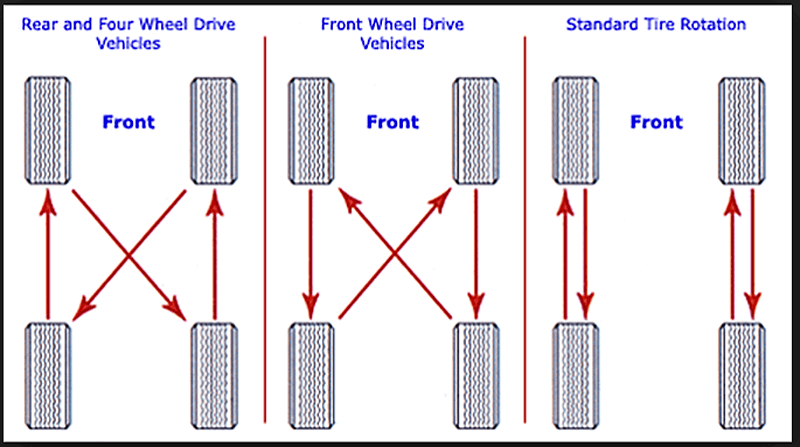 . Let’s take a look at tire rotation patterns recommended by the standardizing body of the tire industry, The Tire and Rim Association, Inc., for all of these possibilities.
. Let’s take a look at tire rotation patterns recommended by the standardizing body of the tire industry, The Tire and Rim Association, Inc., for all of these possibilities.
For vehicles that are 4-wheel, all-wheel, or rear-wheel drive, the rearward cross pattern is recommended. Rear tires are moved to the forward axle and kept on the same side of the vehicle while the front tires are moved to opposite sides of the rear axle.
2. X-PATTERNRecommended for front-wheel drive vehicles such as light-weight trucks and sedans, all tires are moved diagonally, meaning tires are switched from one axle to the opposite as well as being repositioned from one side to the other.
3. FORWARD CROSSThis is the most common pattern for front-wheel drive vehicles. The front axle tires are moved directly back while the rear tires are moved up diagonally to the opposite side of the front axle.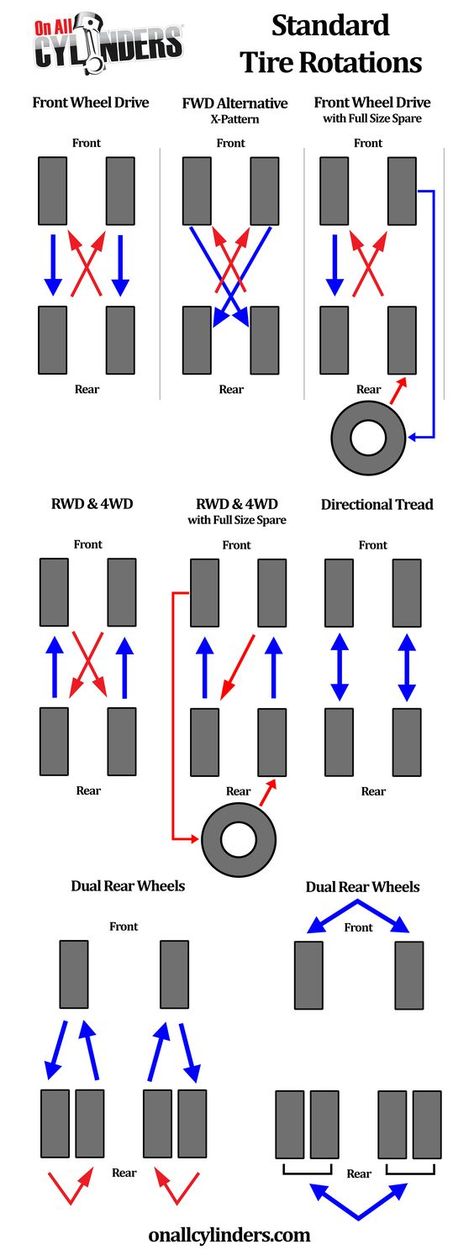
In order to insure that all of the tires on your vehicle have even tread wear, you’ll want to be sure to rotate your full-size spare tire along with the other four. This is especially vital for all-wheel or 4-wheel drive vehicles where even small differences can put undue strain on your car’s drive train.
1. REARWARD CROSS (REAR-WHEEL OR 4-WHEEL DRIVE VEHICLES):Both rear axle tires move directly forward to the front axle while the spare tire moves to the right side of the rear axle. The right front tire moves diagonally back to the left side of the rear axle while the left front tire becomes your new spare tire.
2. FORWARD CROSS (FRONT-WHEEL DRIVE VEHICLES):Rear tires are moved diagonally to opposite sides on the front axle while the right front tire becomes the new spare tire. The spare tire is positioned on the right side of the rear axle while the left tire on the front axle is moved directly back into the left rear position.
All tires are switched with their same-sized partner and remain on the same axle. The two rear tires switch to the opposite side with one another while the two front tires do the same.
2. FRONT-TO-BACK (FOR DIRECTIONAL TIRES)All tires are moved from one axle to the other but remain on the same side of the vehicle. For example, the front left tire is moved to the left side of the rear axle while the rear left tire is repositioned on the left side of the front axle.
Four wheel drive vehicles mainly differ from all wheel drive cars and trucks due to 4WD being more appropriate for off-road use. AWD may have some computer-controlled settings to help it cope with off-road conditions, but it isn’t the same a dedicated low gearing to deal with harsh terrain.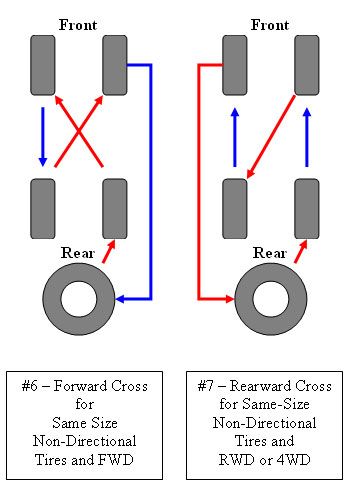
But how does this affect tire rotation patterns for 4WD? The truth is they’re largely the same. There may be some exceptions so you should refer to the vehicle manufacturer guidance in your owner’s manual just to be safe.
4WD Tire Rotation Pattern
There are two acceptable rotation patterns for four wheel drive vehicles. The rearward cross and X-pattern. The rearward cross is the more preferable method since it better distributes the tires around the car or truck over time.
Let’s cover the details of how to deal with rotating tires on 4WD cars and trucks.
4WD systems are not the same as all wheel drive, but they are very similar. The same rotation patterns for AWD work well with 4WD.
There may be situations where a 4WD system works in a unique way and the tires may benefit from a different pattern. Be sure to refer to the owner’s manual provided by your vehicle manufacturer for any unique requirements regarding tire rotation.
The most common tire rotation pattern used on four wheel drive vehicles is the rearward cross. This pattern moves the front tires rearward and across to the opposite sides of the car or truck.
The rear tires move forward but do not switch sides of the vehicle.
The X-pattern is very popular and acceptable to with four wheel drive vehicles. It moves the front tires to the rear and across to the opposite sides of the car or truck. The rear tires move to the front and across to the opposite sides of the vehicle.
The best tire rotation pattern for most four wheel drive vehicles is the rearward cross because it will eventually move every tire to every position and create the most even wear over time.
The X-pattern simply swaps the tires at opposite corners of the vehicle and those tires will never be placed in the other two positions unless the rotation pattern is changed.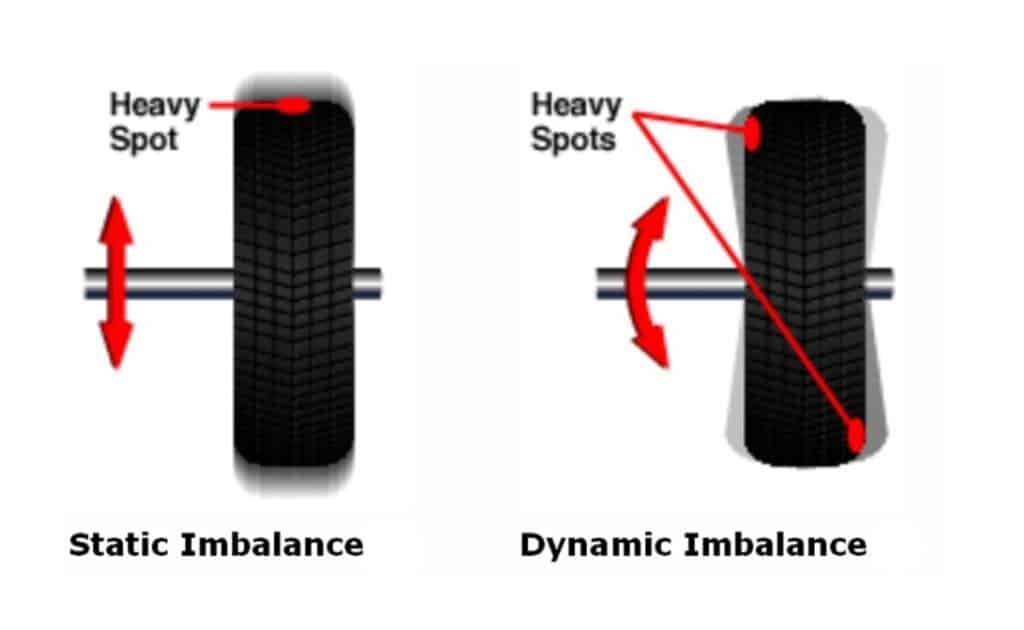
Directional tires can only spin in one direction and must stay on the side of the car or truck they were meant to be used on. If they are moved to the opposite side of the vehicle they will be spinning in the wrong direction and this can be extremely dangerous, especially in wet conditions.
Because directional tires can’t switch sides, they can only be rotated front to rear.
Front to rear tire rotation is fairly obvious. The front tires move to the rear without crossing to the opposite side of the vehicle. The rear tires then move to the front. Also, without changing sides of the car or truck.
Staggered wheels are wheels that are different sizes on the front and rear axles. Sometimes wider or larger wheels and tires are used on the rear to improve handling and traction.
These larger rear wheels and tires should not be moved to the front axle, and hopefully it’s obvious that the smaller front wheels shouldn’t move to the rear axle.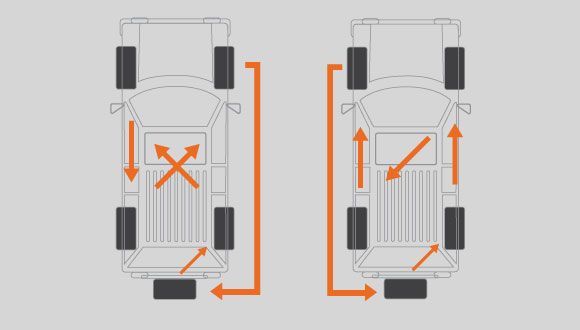
This means that the only pattern of rotation is side to side.
Side to side rotation is very simple. The front tires swap sides and the rear tires swap sides. They do not change which axle they are mounted on, only which end of the axle.
Side to side rotation is of relatively minor benefit but can still be helpful. Especially if your tire manufacturer will honor their tire warranty while you have staggered wheels and tires.
Full size spare tires with wheels that match the four main wheels should be included in regular rotations and can make a big difference in the overall lifespan of the set of tires.
It also ensures the spare tire gets put to good use so that it doesn’t dry rot from age without using the tread depth.
The last important benefit is that the spare tire will be much more likely to be in good condition if you are in a situation where you need to use it.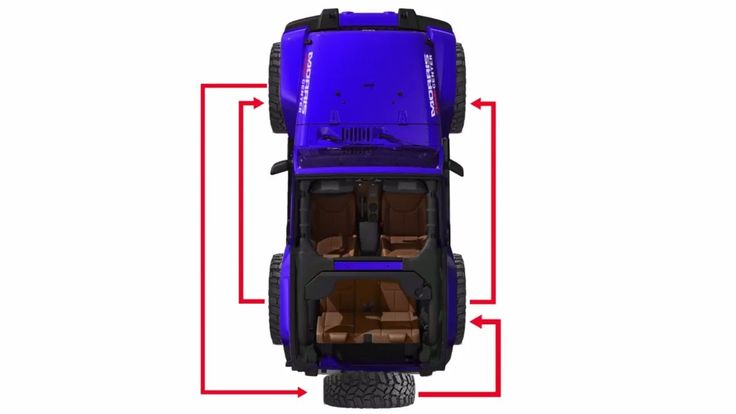 Non-matching spare tires often get forgotten about and can dry rot and lose air pressure over time. When you need your spare tire it may not be usable unless you are diligent about maintaining it.
Non-matching spare tires often get forgotten about and can dry rot and lose air pressure over time. When you need your spare tire it may not be usable unless you are diligent about maintaining it.
The rearward cross 5-tire pattern is a modification of the standard rearward cross. The modification has the driver’s front move to the spare location and the spare go back into service at the passenger rear position.
Tire rotation is usually required to maintain any tire warranty that a tire manufacturer may provide on a set of tires. Maintaining this warranty should be important to you as it can save you a lot of money.
Not all tires will come with a warranty, but you should still have your tires rotated to ensure that they wear as evenly as possible and last a long time.
How often you should rotate your tires is determined by the tire manufacturer and will vary from tire to tire. Each tire manufacturer will specify a mileage interval to not exceed between tire rotations.
Each tire manufacturer will specify a mileage interval to not exceed between tire rotations.
Tire manufacturers usually provide a mileage warranty for their tires and require that the tire rotation mileage not be more than the mileage they set if you expect them to honor any warranty claim.
This mileage amount is usually between 5,000 and 8,000 miles but varies for many reasons. I usually recommend rotating tires at 5,000 mile intervals since it usually will meet or exceed the tire manufacturer requirements.
The terms four wheel drive, four by four, all wheel drive, and full-time four wheel drive get thrown around a lot and often get used improperly.
The overwhelming majority of these systems, regardless of the name, will use rearward cross or x-pattern rotation. This is because almost all will produce more wear on rear tires than front. There may be some front bias systems or some that wear the front tires more and those may benefit from the forward cross pattern.
Refer to your owner’s manual to see what patterns they recommend.
Let’s break down what each means as clearly as possible.
This basically means that all four tires are being used to propel the vehicle forward. This is the parent category for all of the other names.
Typically, 4WD is a feature that allows a two wheel drive to mechanically engage the other axle and become a four wheel drive vehicle.
Full-time four wheel drive cars and trucks are essentially 4WD without the ability to mechanically disable an axle and convert to 2WD. They do usually include the ability to select 4Hi or 4Lo which is a mechanical setting that changes gearing from road and highway use to off-road appropriate gearing.
All wheel drive is the most modern system of 4×4 in some regards, but removes adjustability from the driver. All wheel drive vehicles don’t have a dedicated gearing for off-road purposes and aren’t designed for more demanding off-road situations.
They do tend to be more advanced in that they often rely on computer programming and the use of sensors to adjust grip at each of the four corners of the vehicle. They replace a lot of the dedicated mechanicals with these computer-controlled systems.
Tires are expensive. Four wheel drive off-road tires are very expensive. If you want to get the most tread life out of them, be sure and have them rotated.
Special-purpose tires are less likely to have a warranty. Tire rotation is usually a requirement to prevent your warranty from becoming voided. But if you don’t have a warranty, don’t think that means you can skip rotating your tires. It’s even more important now that you don’t have a warranty to fall back on.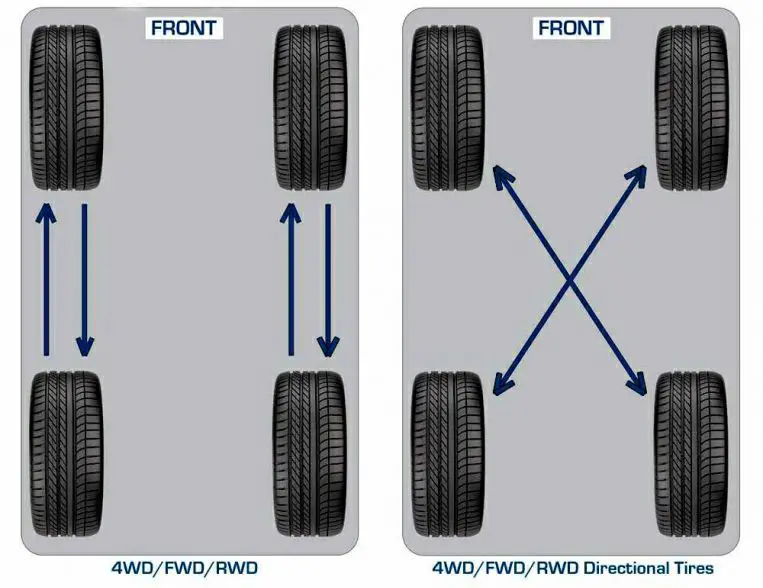
Be sure and follow the guidance of your vehicle manufacturer and the guidance of your tire manufacturer when it comes to tire maintenance. Get the most out of them you can and save yourself some cash in the process.
Below are some links you may find helpful when learning about tires
Will Creech
Will has been an automotive enthusiast since he was old enough to make engine sounds. Formerly a member of the contract training team at Discount Tire, he is unusually knowledgeable on all things related to tires. He is now the owner of and main contributor to TireGrades.com.
All tires are divided into several types and types. During manufacture, tires are marked with a marking that indicates its main parameters and characteristics. We will not delve into the markings, but we will consider the main differences. Tires are divided into two large groups according to the way the cord is laid inside the tire during its manufacture.
We will not delve into the markings, but we will consider the main differences. Tires are divided into two large groups according to the way the cord is laid inside the tire during its manufacture.
These are radial tires and bias tires. Tires of these two types can be winter, summer and all-weather. Each of these three tires can have a regular or directional tread pattern.
A tire with a regular pattern can be installed on either side of the car, a tire with a directional pattern is installed strictly in the direction of rotation. Regular and directional tread patterns can be symmetrical or asymmetrical. A tire with such a pattern is placed according to the rule of a tire with a regular or directional pattern.
It is possible to buy 4 identical tires and assemble them with rims according to the right and left sides of the car. You will get two left wheels and two right ones. Very rarely come across directional tires with an asymmetrical pattern and with an indication of the inside and outside.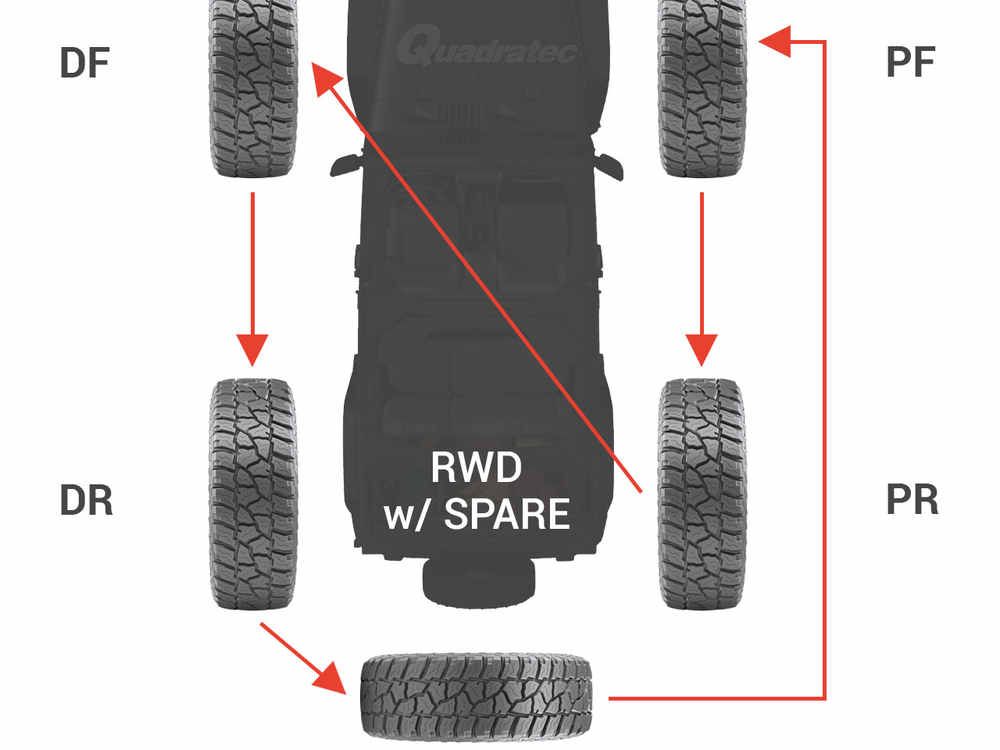 These tires need to buy two on each side. Two right and two left, but it is better to refuse such tires altogether. They are not convenient to use.
These tires need to buy two on each side. Two right and two left, but it is better to refuse such tires altogether. They are not convenient to use.
Radial tires are preferable for cord construction. Such tires are more reliable, they withstand heavy loads during movement, and are more stable during deformation. Radial tires wear longer than diagonal tires. Therefore, tires with a diagonal ply are currently practically not produced. Almost all car owners have two sets of tires. For the operation of a car in the winter - these are winter tires, for the summer period - summer.
All season tires can be used in both summer and winter. Winter tires can be studded. Such tires are allowed only in a few countries, where snow often and abundantly falls in winter, frost forms on the road surface. This list also includes Russia. All-season, summer and winter tires have their own pattern characteristics that increase the car's handling.
Front or rear wheel drive vehicles can be fitted with different tire patterns.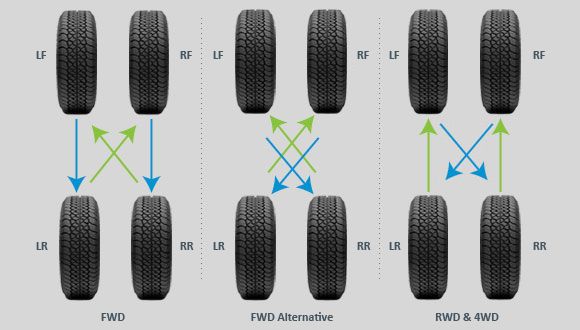 Such tires are installed in pairs on one axle, for example, tires with one pattern are in front, and with another in the back. It is forbidden to install diagonal tires on one axle and radial tires on the other. The dimension must be the same. On all-wheel drive vehicles, the same tires must be installed.
Such tires are installed in pairs on one axle, for example, tires with one pattern are in front, and with another in the back. It is forbidden to install diagonal tires on one axle and radial tires on the other. The dimension must be the same. On all-wheel drive vehicles, the same tires must be installed.
Tires with different treads and dimensions are strictly prohibited. This is due to the design of the transmission. If you operate a car with different tires, then the car's transmission will quickly fail. In addition, driving on different tires becomes dangerous, a car on a slippery road will behave unpredictably.
All car and tire manufacturers recommend changing tires while driving. What is it for? During the operation of the car, all tires wear out unevenly. This is due to several factors. Heterogeneity of the road surface, operating conditions and vehicle transmission device. Therefore, in order to extend the life of the tires and the transmission of the car, the tires must be periodically replaced.![]()
On all-wheel drive vehicles, uniform tire wear is more relevant. Car manufacturers recommend several tire rotation schemes. But in practice, as is often the case, it is impossible or impractical to apply such tire swap schemes. Many car owners never swap tires. Which of course is wrong.
How do you change tires and how often should you do it? The frequency is approximately 8 - 12 thousand kilometers. Therefore, tire swapping can be timed to coincide with the change of tires from summer to winter and vice versa. Winter tires can be studded. When using these tires, the studs tilt to one side. This is due to frequent wheel slip.
Therefore, these tires must be installed in the same direction as they were before. In this case, the tires from the front axle must be put on the rear axle, and the tires from the rear axle should be put on the front axle. In order not to get confused where which wheel was, in a tire shop, the master usually puts a mark on the wheel.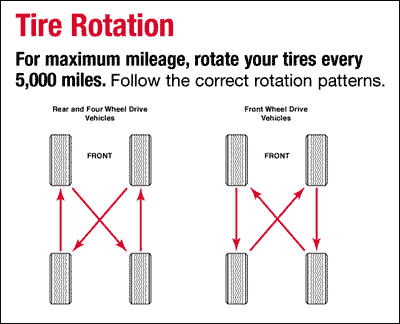 If you apply one of the recommended schemes and change the direction of rotation to the opposite when installing the tires, the spikes will begin to tilt in the other direction, their fastening in the tread will weaken and they will start to fly out.
If you apply one of the recommended schemes and change the direction of rotation to the opposite when installing the tires, the spikes will begin to tilt in the other direction, their fastening in the tread will weaken and they will start to fly out.
Which, of course, does not justify the expediency of rearranging the tires strictly according to the scheme. There is no point in this, the tires will wear out evenly, but the spikes will almost all fall out. If the tires are not studded, but have a directional pattern, the tires must also be rearranged, from the front axle to the rear, from the rear axle to the front, without changing the installation side on the car. If the tires do not have a direction of rotation, then it is possible to apply a more complex scheme.
In this case, the rear tires are moved to the front axle in accordance with the sides. And the front tires are placed on the rear axle, but at the same time the right wheel is placed on the left, and the left wheel is placed on the right. There is another scheme for rearranging wheels. In this scheme, a spare wheel is also involved. The spare must of course be identical. When using such a scheme, the tires wear out a little longer during operation. In this case, the rear tires are rearranged to the front axle without changing sides, the spare wheel is placed on the rear axle on the right, and the right front wheel is placed back on the left. The front left wheel becomes a spare. But such a scheme can be applied if non-studded tires and tires with a non-directional pattern are installed on the car.
There is another scheme for rearranging wheels. In this scheme, a spare wheel is also involved. The spare must of course be identical. When using such a scheme, the tires wear out a little longer during operation. In this case, the rear tires are rearranged to the front axle without changing sides, the spare wheel is placed on the rear axle on the right, and the right front wheel is placed back on the left. The front left wheel becomes a spare. But such a scheme can be applied if non-studded tires and tires with a non-directional pattern are installed on the car.
If the vehicle is fitted with all-season tyres, it is best to change the tires in the middle of the season. That is, in summer and winter, and not during periods of changing seasons. And it turns out that some wheels constantly "ride" on the snow in front, and the other pair - on asphalt in the summer on the rear axle. Wear will again be uneven. When using a rearrangement scheme without the participation of a spare tire, the latter does not wear out.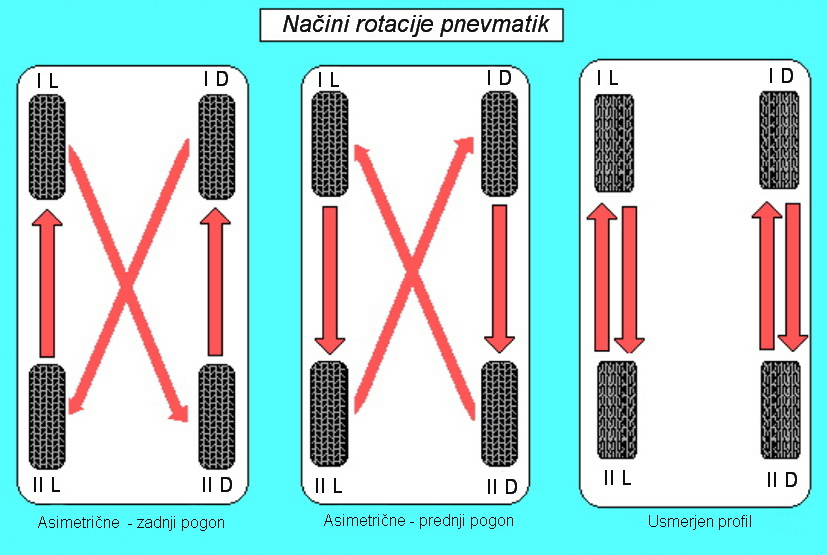 There is a situation when you have to put a spare tire on the car and drive it.
There is a situation when you have to put a spare tire on the car and drive it.
The difference between the tread height of the worn tires and the spare wheel adversely affects the vehicle's transmission. But you can still drive several tens of kilometers. It is advisable to drive as short a distance as possible using the spare wheel.
It happens that a car owner has two sets of fully assembled wheels. That is, when replacing tires, you do not need to constantly bead tires. You just need to change the wheels, for example, from winter to summer. Before changing wheels, they must be balanced. Which will also increase their service life, as well as the service life of the car suspension. Many car owners balance their wheels only when replacing tires with new ones and then drive their entire life. It is not right. During tire wear, the point of imbalance changes. During wheel spin, for example in deep snow, the weight on the disc may move. Therefore, it is necessary to balance the wheels periodically.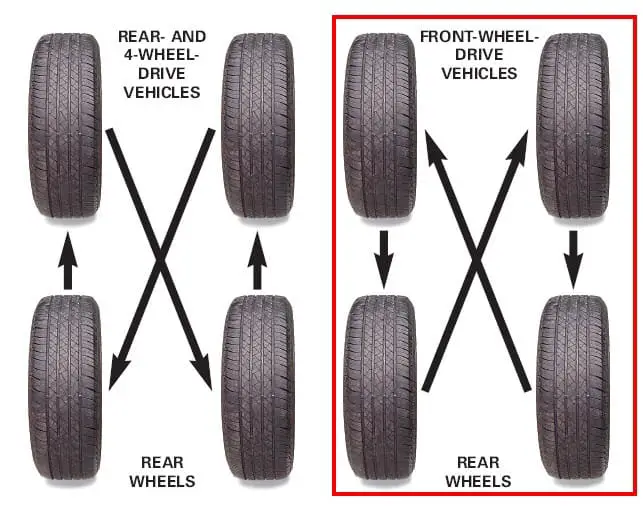
It is the responsibility of the owner or driver to keep track of the condition of their car. Interaxal rearrangement of wheels just refers to one of the types of maintenance. The tire castling rule is not new and has been used by drivers for many decades. Moreover, the procedure is equally useful for cars and trucks.
In addition to maintaining the technical characteristics in the handling of the car, the owners manage to delay the purchase of new wheels. And frugality of the personal budget is encouraged by family members. Unfortunately, the commandment of rubber castling is forgotten. She is remembered at a time of significant wear and tear.
Rearranging wheels on a car significantly extends the life of tires. During the Soviet shortage, car owners treated their wheels more carefully, trying to use their full potential.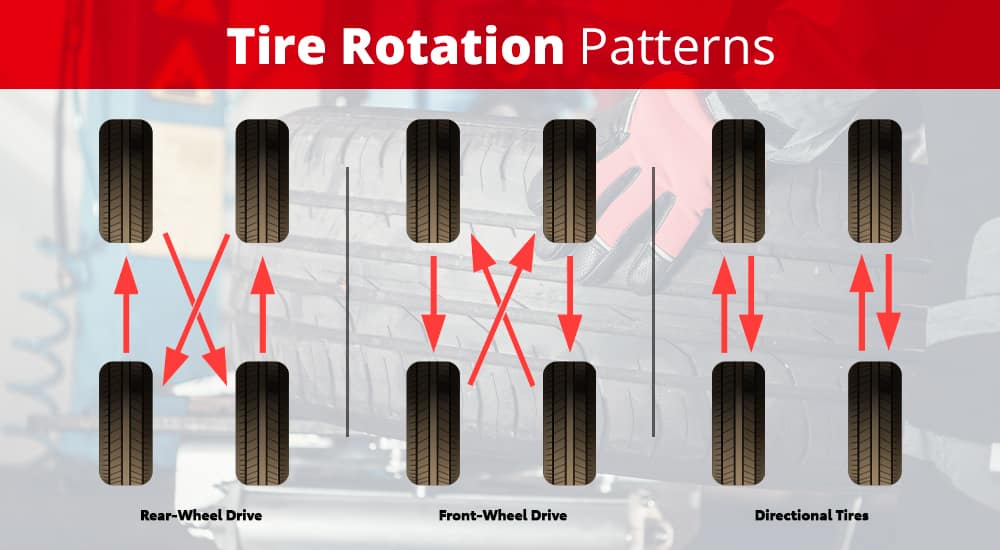 Roughly speaking, rolling the whole set to holes, since it was problematic to get new tires.
Roughly speaking, rolling the whole set to holes, since it was problematic to get new tires.
Nowadays, the market is not in short supply. But, there is another misfortune - the economic crisis. For many years, the population has adapted to rationally spend money. Buying new tires can be a big drain on your personal budget. Therefore, the rule of swapping wheels in places is again relevant today.
In order not to roll the tires to a deplorable state, which will make castling meaningless, it is necessary to get into the habit of keeping a logbook. According to the recommendations of auto exporters, tires should be swapped in places every 10-20 thousand kilometers. The difference in mileage depends on applied factors, among which:
By inspecting the wheels once a week and measuring the pressure, you can monitor changes in the technical condition of the machine.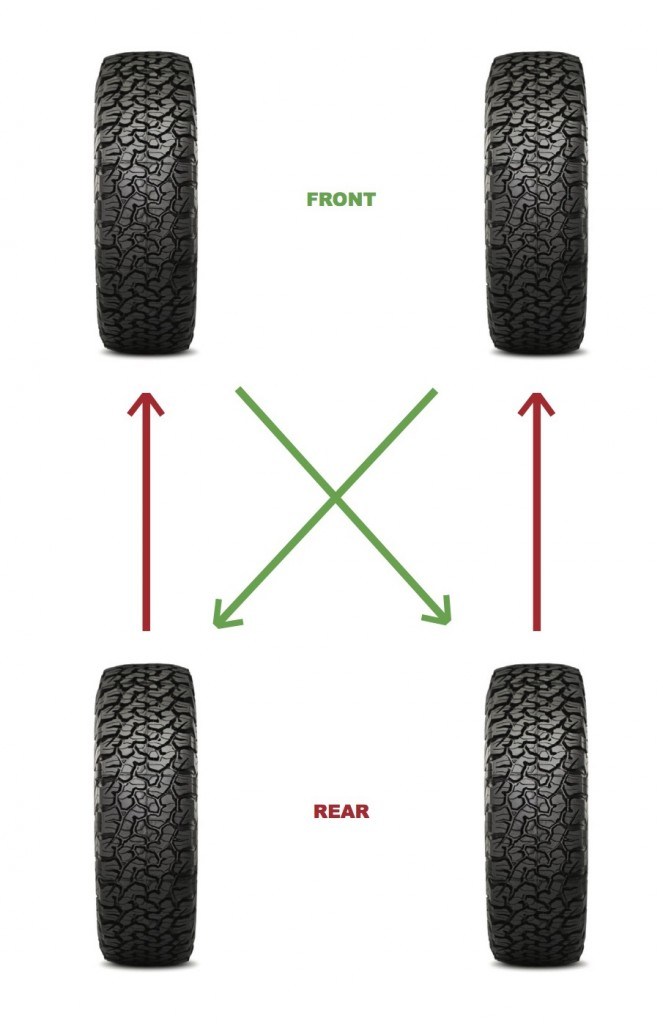 Timely repair and scheduled castling of wheels will ensure uniform wear of rubber.
Timely repair and scheduled castling of wheels will ensure uniform wear of rubber.
The scheme of rearrangement of wheels, will help to make the interchange effective. Before the procedure, it is recommended to mark each tire with a marker to avoid confusion. For each type of car, a specific interchange plan has been developed. Owners of front-wheel drive and all-wheel drive cars can use two options, and owners of rear-wheel drive cars can use one.
 The sequence looks like this: first, the wheels are changed in the sequence of the scheme, which corresponds to the car. Then, the spare tire is installed on the rear axle on the left side, and the removed wheel is sent to the spare compartment.
The sequence looks like this: first, the wheels are changed in the sequence of the scheme, which corresponds to the car. Then, the spare tire is installed on the rear axle on the left side, and the removed wheel is sent to the spare compartment.
If the vehicle is fitted with wheels with an asymmetric tread (Rotation) and installation side (Inner, Outer), diagonal shifting is not possible. Only interaxal castling.
The process can be tedious. Especially if the tires with disks are to be beaded. But if the car owner has a desire to extend the life of the tires, this method of maintenance is necessary. In addition, it will allow the car to meet a certain level of safety. The main condition for success is to permute in the sequence established by the scheme.
Why do this at all? The tread on the rear and front axles wears out differently. The front of the car is more loaded. Regular turns accelerate the wear of the tread corners. In addition, when braking, the main load falls on the front of the car. As a result, tires on the front axle wear out faster. Rear tires are more likely to wear out in the center of the tread. After the rearrangement, the load is placed on the little affected parts of the tread. Therefore, full tire wear will be uniform after castling.
Regular turns accelerate the wear of the tread corners. In addition, when braking, the main load falls on the front of the car. As a result, tires on the front axle wear out faster. Rear tires are more likely to wear out in the center of the tread. After the rearrangement, the load is placed on the little affected parts of the tread. Therefore, full tire wear will be uniform after castling.
The most common tire wear in the center of the tread can be observed on the rear axle of 4WD pickups. Already, after two seasons of operation, the radial middle of the tread of new tires noticeably thins. The main reason is a low load in combination with a stiff suspension.
There is a range of tires that are not subject to center bias. For example, sports cars. They have different tread widths and can only be swapped on one axle. But, this is permissible if they do not have an asymmetric directional tread and strict installation regulations on a certain side.